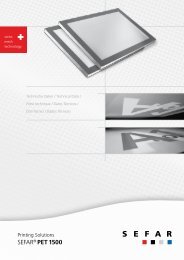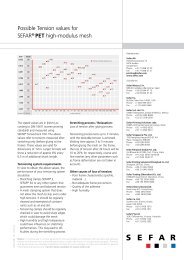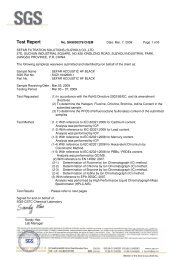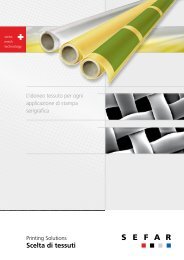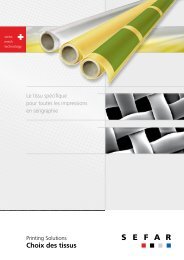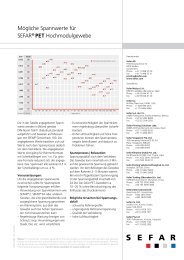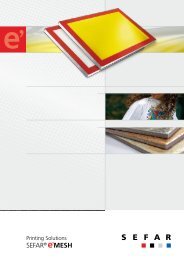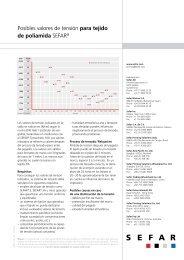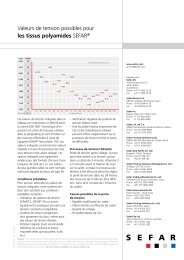Architecture LightFrame – Modular fabric ceilings - SEFAR
Architecture LightFrame – Modular fabric ceilings - SEFAR
Architecture LightFrame – Modular fabric ceilings - SEFAR
You also want an ePaper? Increase the reach of your titles
YUMPU automatically turns print PDFs into web optimized ePapers that Google loves.
Sound reflection<br />
Sound reflection/reverberation<br />
period<br />
Sound which is not absorbed is<br />
reflected and similar physical laws to<br />
those governing optics come into play.<br />
Sound reflection in space is known<br />
as an echo or reverberation, and<br />
reverberation is an important<br />
characteristic when considering the<br />
acoustic quality of a room. It has a<br />
significant influence on the ability<br />
to hear speech clearly and therefore<br />
greatly affects human well-being.<br />
IA-80-CL<br />
woven pore structure<br />
Degree of noise absorption Alpha<br />
1.00<br />
0.90<br />
0.80<br />
0.70<br />
0.60<br />
0.50<br />
0.40<br />
0.30<br />
0.20<br />
0.10<br />
0.00<br />
IA-85-OP<br />
perforated pore<br />
structure<br />
The reverberation period denotes<br />
the time period needed for the sound<br />
pressure to diminish by 60dB.<br />
The measurement is made for various<br />
frequencies. Different locations have<br />
different requirements and thus<br />
recommendations concerning the<br />
reverberation period.<br />
Acoustic test<br />
<strong>SEFAR</strong> ® <strong>Architecture</strong> Fabrics have<br />
undergone are series of tests in an<br />
accredited test institute to determine<br />
their acoustic absorption properties<br />
according to EN ISO 354.<br />
Comparison of different <strong>fabric</strong> types as a double-layer system<br />
Distance <strong>fabric</strong> <strong>–</strong> foil: 80 mm<br />
Distance foil <strong>–</strong> Floor of echo chamber: 220 mm<br />
IL-80-OP foil/floor<br />
IA-80-CL foil/floor<br />
IA-85-OP foil/floor<br />
100 125 180 200 250 315 400 500 630 800 1000 1250 1600 2000 2500 3150 4000 5000 Hz<br />
Single and double-layered<br />
configurations<br />
The absorption coefficient given<br />
describes the relationship between<br />
unreflected and received acoustic<br />
energy.<br />
The <strong>fabric</strong> was measured in single<br />
and double-layered format, as well as<br />
with additional insulating material.<br />
Within the relevant frequency range<br />
of 200 <strong>–</strong>2500 Hertz, peak values<br />
of over 0.9 were recorded.<br />
If <strong>SEFAR</strong> ® <strong>Architecture</strong> Fabrics are<br />
evaluated according to their absorption<br />
class, they achieve a classification from<br />
'high' to 'highest'.<br />
The individual results are summarized<br />
in the acoustic/light technical<br />
information.<br />
Clear test results<br />
Acoustically optimized, photometric<br />
<strong>fabric</strong>s <strong>–</strong> perforated or open-pore<br />
<strong>fabric</strong> assemblies <strong>–</strong> are suitable for<br />
improving sound quality. As <strong>ceilings</strong>,<br />
walls or room dividers, they ensure<br />
dazzle-free light with a high degree<br />
of diffusion while actively reducing<br />
reverberation. In other words they are<br />
demonstrably sound-reducing. Light<br />
transmission coupled with sound<br />
reduction is no longer a contradiction<br />
in terms. (Test values: refer to planning<br />
matrix on page 20).<br />
Frequency<br />
9







